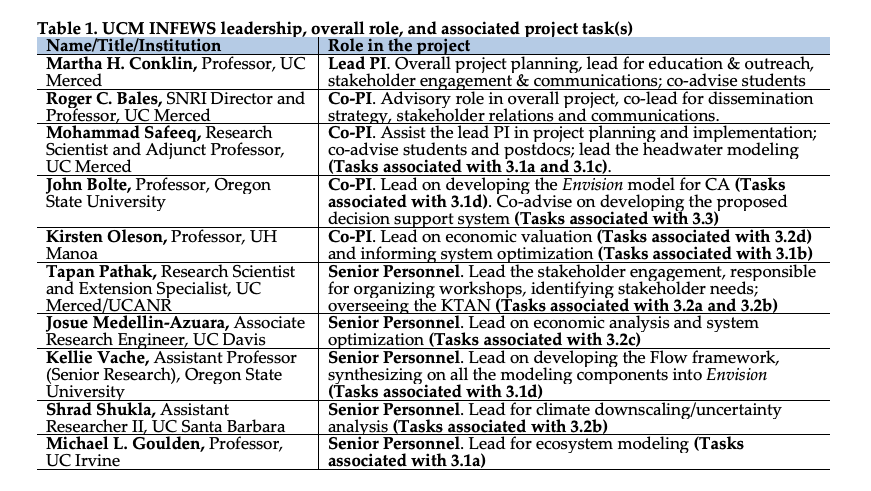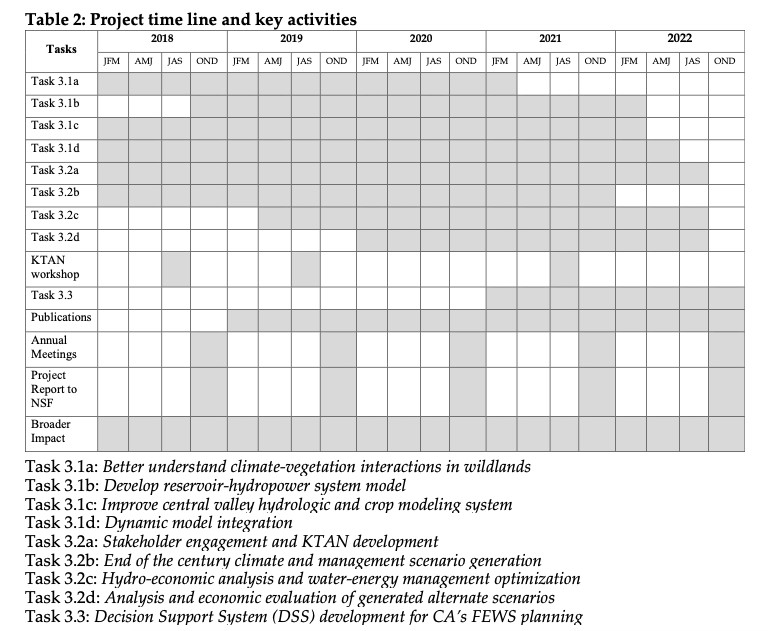INFEWS Project Management Structure:
The lead PI (M. Conklin) will provide overall leadership for the project. PI Conklin is responsible for leading all activities in the project but substantial input is solicited from the Executive Committee. The Executive Committee will serve as the core management team and decision-making group for the project and provides support to the PI in leading and managing the activities of the project. When possible, management decisions will be made by consensus of this group. If consensus cannot be reached, the PI will consult with all members of the project team before making a final decision. An external Advisory Board, made up of two prominent scientists and one stakeholder group per subsystem (wildland, storage, and cropland) in CA, will provide feedback on the year-to-year progress of the project.
The Sierra Nevada Research Institute (SNRI) at UC Merced will provide budgeting, sub-awards, and administrative support. The SNRI, an organized research unit with 35 affiliated faculty members, also has vehicles, equipment and administrative staff to facilitate research and outreach. SNRI provides day-to-day support for the project, including purchasing, travel, reimbursement, sub-awards, and assisting with events such as team meetings, field trips, visitors and the proposed stakeholder workshops.
The broad scope of the project is partly managed through Work Plans prepared by each investigator and collaborator. These Work Plans will describe the scope, schedule, field activities, and planned publications for each sub-award and help facilitate the reporting and outreach. They are updated at least bi-annually and generally encompass the work of a graduate student and associated mentor(s). The Work Plan is also a communication and reference tool for the project team, and most updates focus on the schedule as work progresses. This will ensure the optimal use of resources for the project.
Meetings:
Much of our annual planning will be done during the in-person meetings of the Executive Committee during AGU or here at UC Merced. A second Executive Committee meeting will be held via video conferencing. These meetings will be a forum for science planning and reporting on activities of the entire research team, plus other networking activities. The Executive Committee will also meet bi-monthly throughout the year via web conferencing for planning and decision making, while email and the project research web site will be used frequently to communicate updates. Additional work preparing reports, coordinating field activities, processing and archiving data, and conducting outreach will be done by the subsets of the UCM INFEWS investigators and team. In addition to these meetings, individual PI(s) for sub-award will plan their own monthly meetings and note the progress.

Metrics:
We will measure project success through three key performance metrics for research. These metrics fall under three categories: output metrics, outcome metrics, and impact metrics. Output metrics include the completion of data acquisition, field data collection, model development, publication of data and results online in our digital library and completion of peer-reviewed publications. The data collection, processed data and publications will be tracked. As part of our effort to measure outcomes, we will track citations of our peer-reviewed papers, use of our data, and internet presence. We will also track the number of scientists interested in collaborating and cooperating with our research team. Impacts include better decision making because of our research findings, and improvements to the research process. To achieve broader impacts, we will develop an extensive dissemination network. Our dissemination strategy will aim a range of stakeholder groups. To that end, we have already made progress through parallel efforts from SSCZO and UC Water projects. Through these projects, we have already published opinion pieces in local newspapers, produced video and radio segments through collaborations with regional television and radio stations, presented at numerous stakeholder meetings, and hosted visits to our field sites and laboratories. We have communicated with everyone from foresters and other resource managers, to legislative staff and policy makers at the state and federal level.
Roles and Responsibilities:
Duties for each person on the leadership team are described in general terms as well as key relates to key project tasks described in project narrative (Table 1). Consensus of the Executive Board and rest of research team for logistical execution will decide additional duties.
Research and reporting timeline:
We will start planning and collecting field data (Tasks 3.2a, 3.2d) during the summer and early fall of 2018, and also during the summer of 2019. We will also start the other project activities related to data acquisitions from other sources, model source code, and other software needed. Efforts will be dedicated to run all the modeling components in parallel. Currently we only report the AGU Fall Meeting as a venue for scientific presentation but we will also look for other opportunities (e.g. local workshops and informal meetings) within the region. We also plan to reach out to our stakeholders (e.g. Pacific Gas & Electric (hydropower operations), US Army Corps of Engineers, the CA Department of Water Resources, Resource Conservation Districts, the US Forest Service, and universities and colleges) for arranging informal presentations, workshops, and seminars. Detailed project schedule and timeline for key activities are summarized in Table 2.

Addressing Technical Challenges:
We do not anticipate any technical challenge in developing the proposed model and decision support system. If needed, members of the project team (Shukla and Bolte) have access to high-performance computing clusters that can be utilized for model simulations. In terms of model coupling, the inventory of models within the Envision is quite mature and development of “plug-ins” is fairly straightforward.
Key Deliverables:
1) A detailed and extensive CHANS model for CA FEWS that integrates biophysical, engineering, and socioeconomic components of the system at multiple spatio-temporal scales; 2) Production of alternate future management, policy, and climate scenarios for CA FEWS; 3) A comprehensive system and subsystem level analysis of performance and trade-offs among food, energy, and water under alternate technology, policy, management, and climate scenarios; 4) A mobile friendly decision support system for promoting more resilient FEWS decision-making; and 5) Peer reviewed journal publications and presentations through email, web, and attending scientific meetings and workshops. The CHANS model code and data will be archived with DOI and also published in journals. We will also publish two high impact syntheses papers, one on FEWS modeling and another characterizing the system vulnerabilities and adaptation strategies, that will be useful in generalizing findings to other regions of the country or the world.

